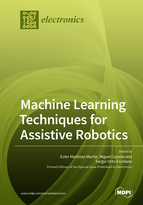Machine Learning Techniques for Assistive Robotics
A special issue of Electronics (ISSN 2079-9292). This special issue belongs to the section "Artificial Intelligence".
Deadline for manuscript submissions: closed (15 March 2020) | Viewed by 59262
Special Issue Editors
Interests: computer vision; deep learning; 3D object recognition; mapping; navigation; robotics
Special Issues, Collections and Topics in MDPI journals
Interests: 3D sensors; deep learning; depth estimation; calibration
Special Issues, Collections and Topics in MDPI journals
Interests: object detection and action recognition
Special Issues, Collections and Topics in MDPI journals
Special Issue Information
Dear Colleagues,
Assistive robots are a category of robots, which share their area of work and interact with humans. Their main objective is to help humans, especially people with disabilities. To achieve this goal, it is necessary that these robots possess a series of characteristics: the ability to perceive their environment from their sensors and act consequently, to interact with people in a multimodal manner, and to navigate and make decisions autonomously. This complexity demands computationally expensive algorithms to be performed in real-time. So, with the advent of high-end embedded processors, several algorithms could be processed concurrently and in real-time.
All these capabilities involve, to a greater or lesser extent, the use of machine learning techniques. New deep learning techniques have enabled a very important qualitative leap in different areas of perception.
Novel theoretical approaches or practical applications of all aspects involving assistive robotics are welcomed. Reviews, datasets, benchmarks, and surveys of the state-of-the-art are also welcomed. Topics of interest to this Special Issue include, but are not limited to, the following topics:
- Emotion recognition models and systems
- Object recognition & pose estimation for assistive robotics
- Activity recognition
- Navigation, localization, and mapping
- Ambient assistive living
- Robot vision
- Applications for people with disabilities
- Scene understanding & description
- Human-robot interaction
- Embedded systems for assistive robotics
Prof. Dr. Miguel Cazorla
Dr. Sergio Orts-Escolano
Dr. Ester Martinez-Martin
Guest Editors
Manuscript Submission Information
Manuscripts should be submitted online at www.mdpi.com by registering and logging in to this website. Once you are registered, click here to go to the submission form. Manuscripts can be submitted until the deadline. All submissions that pass pre-check are peer-reviewed. Accepted papers will be published continuously in the journal (as soon as accepted) and will be listed together on the special issue website. Research articles, review articles as well as short communications are invited. For planned papers, a title and short abstract (about 100 words) can be sent to the Editorial Office for announcement on this website.
Submitted manuscripts should not have been published previously, nor be under consideration for publication elsewhere (except conference proceedings papers). All manuscripts are thoroughly refereed through a single-blind peer-review process. A guide for authors and other relevant information for submission of manuscripts is available on the Instructions for Authors page. Electronics is an international peer-reviewed open access semimonthly journal published by MDPI.
Please visit the Instructions for Authors page before submitting a manuscript. The Article Processing Charge (APC) for publication in this open access journal is 2400 CHF (Swiss Francs). Submitted papers should be well formatted and use good English. Authors may use MDPI's English editing service prior to publication or during author revisions.







